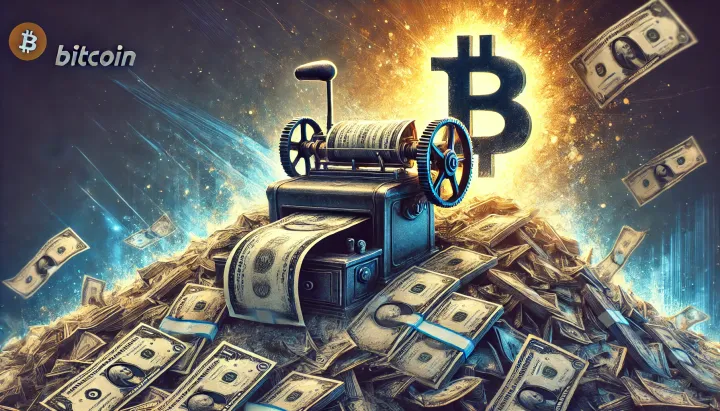Bitcoin’s Deflationary Discipline
The April 23 2025 episode of What Is Money? pairs host Robert Breedlove with Jeff Booth to dissect why technological deflation cannot coexist with fiat’s inflationary debt spiral.

- My 'briefing notes' summarize the content of podcast episodes; they do not reflect my own views.
- They contain (1) a summary of podcast content, (2) potential information gaps, and (3) some speculative views on wider Bitcoin implications.
- Pay attention to broadcast dates (I often summarize older episodes)
- Some episodes I summarize may be sponsored: don't trust, verify, if the information you are looking for is to be used for decision-making.
Summary
The April 23 2025 episode of What Is Money? pairs host Robert Breedlove with Jeff Booth to dissect why technological deflation cannot coexist with fiat’s inflationary debt spiral. Booth argues that Bitcoin’s energy-anchored protocol offers the first truly global free market, but only if users spend and accept sats rather than parking coins in custodial ETFs. He warns that medium-of-exchange growth, not price appreciation alone, determines whether Bitcoin liberates or recentralizes economic power.
Take-Home Messages
- Custodial Risk: Centralized ETFs can concentrate economic nodes and invite political protocol capture.
- Spend or Stagnate: Routine Lightning payments secure decentralization by rewarding miners and routing hubs.
- Debt Time-Bomb: A $600 trillion fiat overhang ensures either mass default or perpetual debasement.
- Tech Wants Deflation: Bitcoin aligns exponential innovation with falling consumer prices and higher real wages.
- Global Inclusion: Circular Bitcoin economies give resource-exporting nations leverage over exploitative trade terms.
Overview
Jeff Booth opens by branding inflation “the greatest lie ever told,” insisting that free-market innovation should push prices toward zero while raising living standards. Instead, fiat currencies require perpetual inflation to erode impossible debt, forcing society into a zero-sum scramble for scarce purchasing power. Breedlove highlights how this contradiction fuels social unrest and geopolitical tension.
Booth quantifies the problem: more than $600 trillion in global obligations cannot be repaid, so policymakers must either default or debase. He contrasts that trap with Bitcoin’s hard cap, calling it an “open, decentralized, secure protocol bounded by energy” that restores honest pricing. Measured in sats, he notes, housing and commodities already deflate, revealing fiat’s hidden tax.
Booth warns that treating Bitcoin purely as digital gold risks recentralization. If most coins sit inside regulated ETFs or stablecoin rails, a handful of custodians could veto transactions or force a compliant fork. Only real circular spending—wallet-to-wallet payments over Lightning, Liquid, or Ark—keeps economic nodes sufficiently distributed.
Booth links monetary truth to personal change, arguing that self-custody and proof-of-work cultivate radical responsibility. He foresees eight billion people cooperating rather than competing once technological abundance flows directly to them. The episode closes with practical defenses: ubiquitous non-custodial tools, miner integration with renewable grids, and education that reframes deflation as prosperity, not peril.
Stakeholder Perspectives
- Central banks – Fear loss of seigniorage and may tolerate savings use while suppressing peer-to-peer payments.
- Regulated custodians – Gain fee income from warehousing coins but risk political fallout if perceived as single points of failure.
- Energy producers – View mining as a demand-response buyer that monetizes stranded or surplus power.
- Global South exporters – See sats invoicing as protection against debasing local currencies and predatory contract terms.
- Retail savers – Chase price appreciation yet remain vulnerable to “paper Bitcoin” if self-custody education lags.
Implications and Future Outlook
If Lightning commerce outpaces custodial hoarding, miner revenue will diversify and protocol governance will remain decentralized. A deflation-based economy could shrink debt ratios organically while elevating real wages, easing fiscal and social strains. Policymakers must adapt to falling prices by taxing consumption or land rather than inflation.
Energy markets stand to shift as producers realize Bitcoin mining stabilizes grids and monetizes renewables. Nations that embrace this synergy may attract capital and talent, while those that ban mining risk offshoring both innovation and emission reductions. Credible environmental metrics will determine whether proof-of-work becomes a climate scapegoat or a grid-balancing ally.
Socially, a cooperative “eight billion for eight billion” coordination game could displace today’s adversarial politics. Broader use of sats empowers Global South entrepreneurs, erodes extractive middlemen, and realigns incentives toward transparent trade. Education that links personal responsibility to monetary sovereignty will be pivotal during the transition.
Some Key Information Gaps
- What incentives will drive everyday spending in Bitcoin-denominated transactions? Identifying viable rewards and user-experience designs is critical for decentralization, policy relevance, and timely adoption.
- How much custodial concentration allows regulators to coerce protocol changes via economic nodes? Quantifying this threshold guides technical priorities for non-custodial tooling and informs antitrust scrutiny.
- Which debt-unwind scenarios are most probable if central banks persist with near-zero rates? Scenario analysis equips policymakers and investors to manage systemic-risk timing and cross-border contagion.
- What Bitcoin adoption pathways can empower Global South producers in resource negotiations? Exploring pilot programs and invoicing models could generalize inclusive trade frameworks and boost geopolitical stability.
- How will proof-of-work’s energy mix evolve under aggressive renewable deployment? Empirical clarity on grid impacts steers climate policy, infrastructure investment, and public perception of mining.
Broader Implications for Bitcoin
Monetary Sovereignty Reimagined
Bitcoin’s hard cap displaces central-bank seigniorage as the fulcrum of fiscal power. Governments that cannot print at will must legitimize spending through transparent taxation, likely shrinking bureaucratic scope. A hybrid reserve model blending Bitcoin with strategic commodities may emerge as nations hunt credibility.
Energy-Market Reconfiguration
Proof-of-work anchors electricity to a global clearing price, incentivizing continuous grid optimization. Stranded gas, curtailed wind, and off-peak nuclear output become exportable in hash form, spurring investment in modular generation. Regions that align regulation and infrastructure can transform from energy backwaters into industrial hubs.
Inclusive Innovation Boom
When eight billion minds transact on honest money, capital allocation tilts toward productive risk-taking over rent-seeking. Lower barriers to entry enable entrepreneurs from Lagos to La Paz to monetize ideas without currency-conversion drag. The resulting talent surge could compress technology-diffusion cycles and accelerate human development indicators.
Governance and Human Rights Shift
A censorship-resistant medium of exchange limits authoritarian leverage over dissidents and minority groups. Grassroots fundraising, uncensored media, and cross-border remittances reduce reliance on patronage networks, fostering pluralistic politics. International bodies may face pressure to update norms around financial surveillance and sanctions.



Comments ()